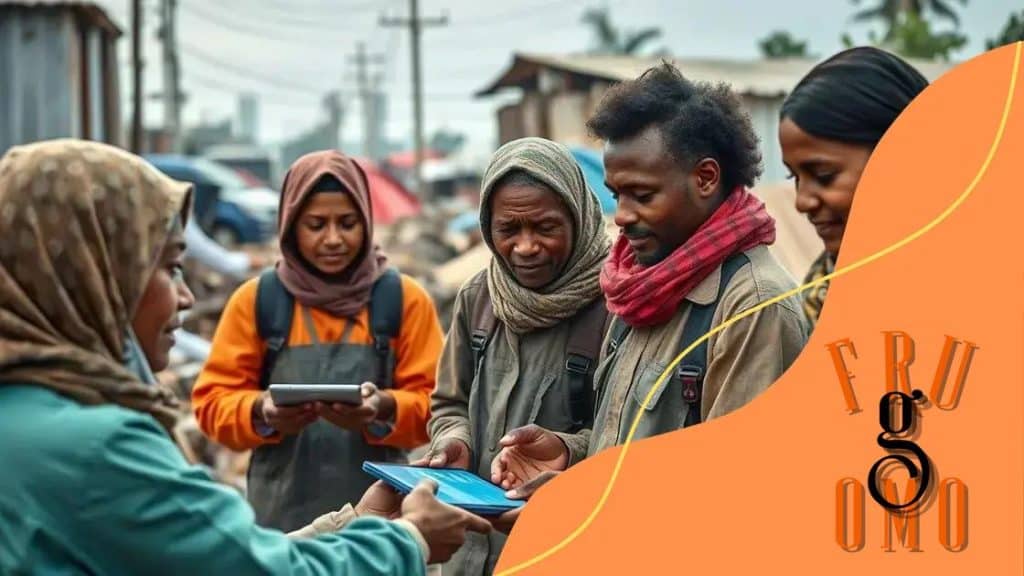Blockchain for transparent humanitarian aid: a game changer

Blockchain for transparent humanitarian aid improves accountability and efficiency by providing secure, real-time tracking of donations and direct transactions, ensuring that aid reaches those in need quickly and effectively.
Blockchain for transparent humanitarian aid is transforming how we deliver support in crisis scenarios. Have you ever wondered how transparency can build trust in aid distribution? Let’s dive in!
Understanding blockchain technology
Understanding blockchain technology is essential to grasp its impact on various sectors, especially in humanitarian aid. This innovative system provides a secure and transparent way to record transactions, ensuring accountability.
What is Blockchain?
Blockchain is a distributed ledger technology that allows multiple parties to have access to the same data in real-time. Each transaction is recorded in a block and linked to previous blocks, creating a chronological chain of information. This process is encrypted and immutable, meaning once data is added, it cannot be altered without consent from the network.
Key Features of Blockchain Technology
- Transparency: All transactions are visible to participants, reducing fraud.
- Decentralization: No single entity controls the data, increasing trust among users.
- Security: Advanced cryptography protects data against unauthorized access.
- Efficiency: Smart contracts automate processes, saving time and resources.
The effectiveness of blockchain in humanitarian efforts stems from its ability to provide real-time data. For instance, organizations can track where aid is being distributed, ensuring it reaches those in need. By eliminating intermediaries, the cost of aid delivery is reduced significantly, allowing more funds to go directly to beneficiaries.
Moreover, blockchain technology fosters trust. Donors can see how their contributions are being used, empowering them to make informed decisions about their support. This level of accountability is crucial in humanitarian work, where every dollar matters.
As we explore the role of blockchain in humanitarian aid, it’s clear that understanding this technology can lead to more effective solutions and greater impact in crisis situations.
How blockchain enhances humanitarian transparency
Blockchain enhances humanitarian transparency by providing a reliable and open system for tracking donations and aid delivery. This technology allows organizations to see where funds are allocated and ensures that they reach the intended recipients.
Real-Time Tracking
One of the key benefits of blockchain technology is real-time tracking. With this feature, every transaction is recorded instantly, which means that donors can see how their contributions are being utilized. For example, if a donation is made for a specific project, the blockchain can show the exact status of that project and how funds are spent.
Improved Accountability
- Clear Audit Trails: Blockchain creates permanent records that cannot be altered, which helps in auditing transactions.
- Reduced Fraud: By making data public and secure, it minimizes the chances of misuse.
- Trustworthy Reporting: Organizations can provide accurate reports to stakeholders, reinforcing their credibility.
Transparency fosters trust between aid organizations and donors. When people see that funds are used properly through secure and transparent processes, they are more likely to contribute. This trust is crucial, especially in crisis situations where every donation counts.
Moreover, transparency helps humanitarian organizations adhere to regulatory requirements. By having detailed records of all transactions, they can ensure compliance with laws and regulations, reducing the risk of legal complications.
As blockchain continues to evolve, its role in promoting transparency within humanitarian efforts will likely grow. By enabling secure and traceable donations, blockchain technology is set to revolutionize how we approach crisis response.
Case studies of blockchain in aid delivery

Case studies of blockchain in aid delivery illustrate the real-world applications of this technology, showcasing its potential to revolutionize humanitarian efforts. Several organizations have already adopted blockchain to improve efficiency and transparency in their operations.
World Food Programme
The World Food Programme (WFP) is a leader in utilizing blockchain for food distribution. They implemented a system called Building Blocks, which enables refugees to access food without the need for cash or physical identification. Each transaction is recorded on the blockchain, allowing for real-time tracking of food assistance.
Banqued
Another example is Banqued, which focuses on delivering aid through mobile banking. This platform allows clients to receive funds directly into their accounts, ensuring that aid reaches them quickly and securely. Banqued uses blockchain to maintain a secure record of transactions, promoting trust among stakeholders.
UNICEF
- Innovative Fund: UNICEF has set up a fund to invest in blockchain startups. These initiatives aim to enhance aid delivery and improve transparency.
- Tracking Donations: They use blockchain to track cryptocurrency donations, ensuring that contributions are spent correctly.
- Improving Impact: By monitoring how funds are used, UNICEF can report back to donors effectively and maintain accountability.
These case studies highlight the effectiveness of blockchain in humanitarian aid. Implementing such systems enhances the overall impact of aid organizations by allowing them to operate in a more accountable and efficient manner. As more organizations adopt blockchain technology, we can expect to see even greater improvements in the delivery of humanitarian aid.
Challenges in implementing blockchain
Challenges in implementing blockchain can pose significant hurdles for organizations, especially in the humanitarian sector. Despite its potential, several factors can complicate its adoption.
Technical Complexity
The technical nature of blockchain can be a barrier. Many organizations face difficulties in understanding how blockchain works and how to integrate it into their existing systems. This complexity can lead to misinformation and skepticism among stakeholders.
Cost Concerns
Another challenge is the cost of implementing blockchain technology. Setting up the infrastructure requires significant investment in terms of both time and resources. Smaller organizations, in particular, may struggle to justify these expenses.
Data Privacy Issues
- Public vs. Private Blockchains: Choosing between public and private blockchains can lead to debates about data accessibility.
- Compliance: Organizations must navigate privacy laws to ensure they are not violating regulations.
- Security Risks: While blockchain is secure, it is not immune to hacks, which raises concerns about data protection.
Resistance to change can also hinder the adoption of blockchain. Employees and stakeholders may be reluctant to shift from traditional methods to newer technologies. This resistance often stems from a lack of knowledge about blockchain’s benefits and how it can improve processes.
Finally, collaboration among various stakeholders is crucial for the successful implementation of blockchain technology. Without cooperation from all parties involved, achieving the desired outcomes can be challenging. Each organization must recognize the value of contributing to a shared system that ultimately enhances humanitarian efforts.
Future prospects for blockchain in humanitarian efforts
Future prospects for blockchain in humanitarian efforts are bright as more organizations begin to recognize its potential. This technology is poised to change how aid is delivered and managed, leading to greater efficiency and transparency.
Increased Adoption
As awareness grows, an increasing number of humanitarian organizations are looking to adopt blockchain solutions. More partnerships are being formed between tech companies and non-profits, creating innovative approaches to aid distribution. This collaboration can help streamline processes and improve outcomes for those in need.
Growth of Decentralized Solutions
Decentralized solutions are expected to rise. By eliminating middlemen, blockchain allows for direct transactions between donors and recipients. This reduces costs and ensures that aid reaches those who need it most, quickly and efficiently.
Enhanced Data Management
- Improved Tracking: Future blockchain systems will enable more precise tracking of donations and aid distribution.
- Real-Time Updates: Beneficiaries can receive real-time information about their aid, increasing participation and awareness.
- Effective Reporting: Organizations can generate better reports for stakeholders, showcasing the impact of their efforts.
As the technology matures, we may also see advancements in security and data privacy. These enhancements will likely build further trust in blockchain systems, encouraging wider use in humanitarian sectors. Moreover, innovative applications like smart contracts could automate payment processes, making transactions faster and more reliable.
The integration of blockchain with other technologies, such as artificial intelligence and the Internet of Things (IoT), could lead to even more substantial improvements in how humanitarian aid is delivered. By leveraging data from various sources, organizations can better understand needs and respond promptly.
In conclusion, the future of blockchain in humanitarian efforts holds great promise. By enhancing transparency, improving accountability, and streamlining aid delivery, blockchain can transform how we respond to crises. While challenges exist, such as technical complexity and cost, the potential benefits far outweigh the obstacles. As more organizations explore and implement blockchain solutions, we can expect significant advancements in ensuring that aid efficiently reaches those in need. Together, we can harness the power of blockchain technology to create a more effective and transparent humanitarian landscape.
FAQ – Frequently Asked Questions about Blockchain in Humanitarian Efforts
How can blockchain improve transparency in humanitarian aid?
Blockchain allows all transactions to be recorded publicly, ensuring that donations are tracked and spent properly, which increases trust.
What are the main challenges in implementing blockchain in aid organizations?
Key challenges include technical complexity, high costs, and resistance to change among staff and stakeholders.
How does blockchain enhance accountability in aid delivery?
By creating immutable records of transactions, blockchain helps ensure that organizations can be held accountable for how funds are utilized.
What is the future of blockchain in humanitarian efforts?
Future prospects include increased adoption, improved data management, and the growth of decentralized solutions that streamline aid delivery.





